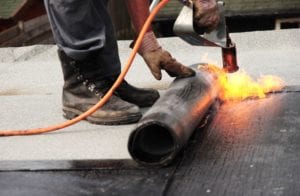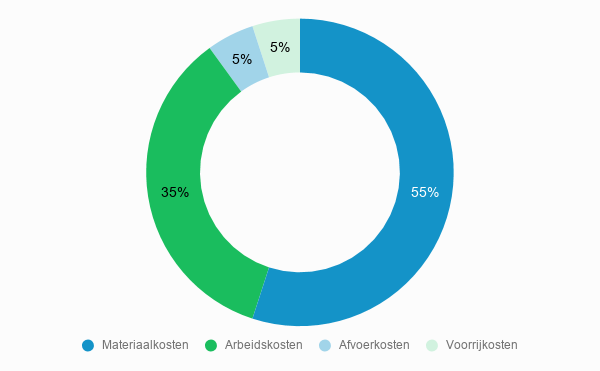Bitumen roofing, also known as roofing leather, is widely found on Dutch flat roofs. This is because bitumen is extremely strong and often provides a watertight roof for up to 30 years. Are you curious about what exactly bitumen roofing is and how much it costs for your roof? Read this article for useful information about bitumen roofing and get an idea of the average cost.
What does bitumen roofing cost per m²?
Bitumen roofing is one of the cheapest forms of roofing. On average, the price is approximately between £50 and £90 per m². Despite the relatively low cost, bitumen roofing protects your house, shed or garage for decades. Take a look at the average prices of a bitumen roof per m² below.
| Work | Price per m² (incl. labour costs and VAT) |
|---|---|
| Applying bitumen over old roofing | £50 |
| Old roofing removed and bitumen roofing installed | £90 |
Find the best specialist for your project and get free quotes.
Start

What is bitumen roofing?
Bitumen is a form of roofing material that has been commonly used on flat roofs in the Netherlands for decades. Bitumen is also called bituminous roofing or roofing leather. It is a material made from petroleum which used to be combined with glass fleece. Since that combination made the roofing material not UV-resistant, plastic is often added nowadays. In most cases, this is APP or SBS.
Bitumen roofing generally costs less than other types of roofing, but on the other hand, it does not last as long. Its lifespan is about 30 years.
Roofing made of bitumen comes in black as standard, but you can also choose, for example, red, brown or white. The colour of bitumen not only determines the appearance of your home, but also affects the temperature of your roof. White roofing reflects sunlight, keeping the roof cooler on hot days. While black bitumen roofing, on the other hand, gets very hot on hot days.
What types of bitumen roofing are there?
Bitumen is by nature a non-elastic material. This is why bitumen is often processed before it is used as roofing material. The two most common types of processed bitumen are APP and SBS bitumen.
APP stands for Atactic Polypropylene and SBS for Styrene Butadiene Styrene. Both types are an excellent form of roofing and roofers are skilled in laying both APP and SBS bitumen.
APP bitumen
APP is a combination of bitumen and plastic plastic. The addition of plastic allows the roofing to withstand extreme temperatures and is UV-resistant. It also ensures a longer lifespan.
SBS bitumen
SBS is composed of elastomer. It is a synthetic rubber that provides greater elasticity to the bitumen. This allows the roofing membranes to move with it when the roof expands or shrinks.
The main difference between these two types is that APP is more resistant to UV rays than SBS, because a lot of plastic has been added to APP. SBS, on the other hand, can also be protected from UV radiation by applying a special coating to it.
All differences and prices are shown in the comparison table below.
| Average price per m² (incl. labour costs and vat) | £ 48 – £ 53 | £ 50 – £ 55 |
| Lifespan | Approximately 30 years | Approximately 30 years |
| Advantages | – Highly resistant to UV radiation – Low maintenance – Easy to repair |
– Strong adhesion to the substrate – Elasticity allows the underlying material to grow and shrink due to temperature fluctuations – Easy to repair |
| Disadvantages | – Vulnerable to root growth and weeds | – When exposed to high UV radiation, the material becomes porous, therefore gravel is needed for protection – Vulnerable to root growth and weeds |
How is it applied to your roof?
Bitumen roofing can be laid over an old layer, but it is also possible to remove the old layer first and then apply the new one. Bitumen comes on a roll and is applied to your roof in strips. It is important here that the strips overlap by at least 10 cm to prevent leaks.
There are four ways in which bitumen can be applied:
- Loose-laid system
- Fully bonded system
- Mechanically fastened system
- Partially bonded system
Loose-laid system
In this way, the underlayment is applied loosely to the substrate. After which the bitumen layer is burned firmly onto the substrate. As the bitumen is not bonded to the substrate, cracks and damage are less likely to occur. To protect the entire surface, an additional ballast layer is applied. This ballast layer reflects UV rays, which means the roof ages less quickly. Gravel or tiles are often chosen for this purpose.
Fully adhered system
With this method, the bitumen roofing is fully adhered to the substrate of the roof. In most cases, a gas torch is used for this purpose, but it can also be done with cold adhesives or by the pouring method.
Mechanically fastened system
With a mechanical system, an underlayment is first placed and fastened with roof drilling screws and shims. Then, the bitumen roofing is torched onto this underlayment.
Partially bonded system
When a new layer of bitumen is laid over an old layer, a partial bonded system is often chosen. This method prevents blistering, thus preventing moisture or water vapour from getting under the roofing.
What are the advantages and disadvantages of bitumen roofing?
Check out the pros and cons of bitumen roofing below and decide if this type of roofing is right for your roof.
Advantages
- Strong material
- High waterproofing
- UV-resistant (with APP or a coating)
- Adhesive strength is very high
Disadvantages
- High flammability
- Relatively long lifespan, but not as long as other types of roofing.
How is the price composed?

Find the best specialist for your project and get free quotes.
Start
Frequently asked questions
Roofing bitumen costs on average £50 to £90 per m². The total price depends on your roof area and whether you have the old roofing removed first or have it applied over the old. Get free and no-obligation quotes to find out how much your project will cost.
The average lifespan of bitumen roofing is about 30 years. This is a relatively long time, but compared to other types of roofing a lot shorter.
EPDM and bitumen are both commonly chosen forms of roofing and are ideally suited for flat roofs. Both types have their advantages and disadvantages. EPDM is a type of rubber sheeting, has a lifespan of about 40 years and is generally slightly higher than bitumen in terms of price. Bitumen is made from petroleum and has a slightly shorter lifespan of 30 years on average, but is again cheaper.